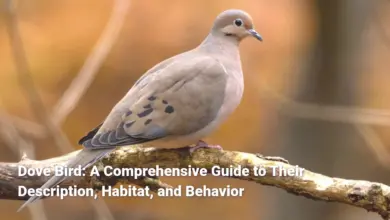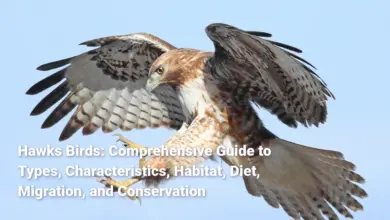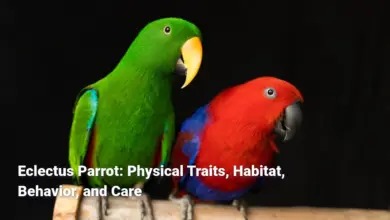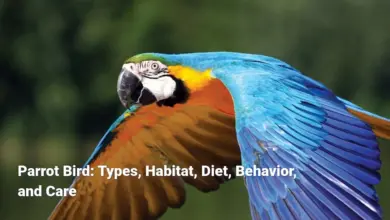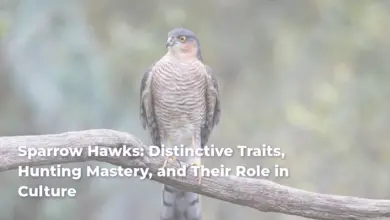Red-Tailed Black Cockatoo: Physical Characteristics, Habitat, Behavior, and Conservation
The Red-tailed Black Cockatoo, known scientifically as Calyptorhynchus banksii, is a striking and significant bird species native to Australia. This magnificent bird boasts impressive physical features, rich cultural significance, and specific behavioral patterns that capture the attention of both birdwatchers and conservationists. With its distinct plumage and vocalizations, the Red-tailed Black Cockatoo has become a symbol of the diverse wildlife that thrives in Australian ecosystems. This article aims to dive into the physical characteristics, habitat, diet, social behavior, breeding habits, conservation status, and cultural importance of this extraordinary bird species, ultimately bringing awareness to the importance of preserving its habitat for future generations.
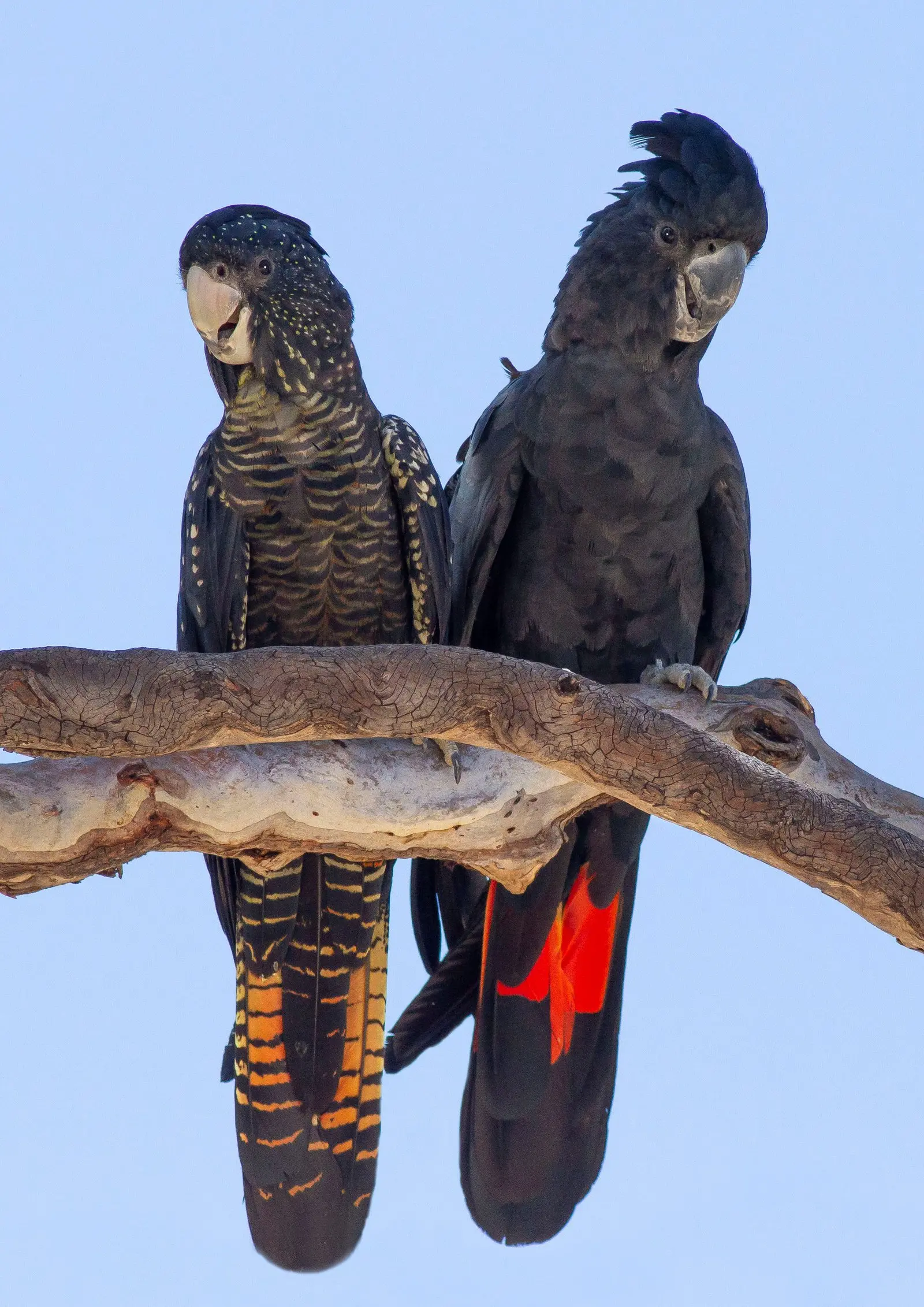
As we explore the world of the Red-tailed Black Cockatoo, we will reveal its many nuances, from its striking appearance to its complex social structure. This bird represents more than just a dazzling display of nature’s artwork; it also embodies the delicate balance of ecosystems it inhabits. Ecosystems that nurture this iconic bird are under constant threat from urban development, agriculture, and climate change. Understanding the Red-tailed Black Cockatoo is crucial in recognizing the need for conservation efforts that protect not only this species but the myriad of life interconnected within its habitat.
Physical Characteristics
The Red-tailed Black Cockatoo is known for its striking and contrasting physical features that make it easily recognizable among Australia’s avian life. Adult males showcase a glossy black plumage, which appears almost like fine silk when the sun reflects off its feathers. This striking appearance is complemented by their long and elegant tail feathers, adorned with bright red panels that breathe life into their dark exterior. In contrast, female Red-tailed Black Cockatoos exhibit a more muted coloration. Their feathers are typically a deep black, but they feature subtle yellow markings that adorn their head, neck, and wings, providing a warmer and more intricate overall appearance.
Plumage Specifications
| Trait | Male | Female |
|---|---|---|
| Base Color | Glossy black | Duller black with yellow markings |
| Tail Color | Bright red panels | Yellow-orange striped with barred patterns |
| Head and Neck | Solid black | Yellow spots on head and neck |
| Bill | Dark grey | Pale, horn-colored |
Both males and females possess a long, erectile crest that serves as a dramatic display feature, especially during courtship or territorial disputes. This crest can be raised or lowered and plays a significant role in communication. Their strong, curved beaks are uniquely adapted for cracking open seed pods, showcasing their role as seed dispersers within their habitat.
When considering size, male Red-tailed Black Cockatoos typically measure between 55 and 60 centimeters in length, averaging around 900 grams in weight. Females are slightly smaller, usually ranging between 615 to 920 grams, and scale between 55 to 60 centimeters in length. Their wingspan spans an impressive 110 centimeters, enabling them to glide gracefully through their natural environments.
The vivid sexual dimorphism present in these birds notably their dissimilar plumage serves multiple purposes. Beyond aesthetics, these differences may play pivotal roles in reproductive displays and survival tactics. For example, the striking visual of a vibrant male may allure females and deter rival males. The contrast between their respective plumages also provides opportunities for camouflage in varying environments, ultimately enhancing the bird’s survival.
Size and Weight
The size and weight of the Red-tailed Black Cockatoo contribute significantly to its presence in the wild. These birds, measuring between 55 to 60 centimeters in length, are certainly not small they are robust and built for flight. To provide further context, let’s explore the size and weight parameters set forth in the comparison below:
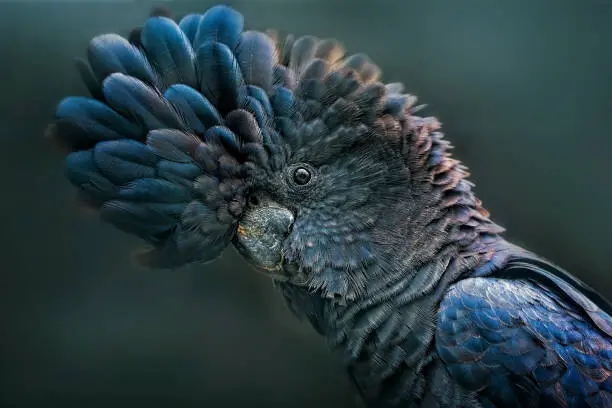
- Length: The overall length of the Red-tailed Black Cockatoo ranges from 55 to 60 centimeters (approximately 21.7 to 24 inches).
- Wingspan: This remarkable bird possesses a wingspan that stretches up to 110 centimeters, showcasing incredible flight capabilities.
- Weight:
- Males typically weigh between 670 to 900 grams.
- Females show slight variability in weight, averaging between 615 to 920 grams.
This variability in size not only denotes differences between gender but also illustrates the bird’s adaptability to its environment. Males, being larger on average, may require a greater intake of food to sustain their energy levels for mating displays and territorial flights. Their physical presence greatly influences their role within the ecosystem as both foragers and caregivers.
One interesting observation is how size can affect social behavior. Larger males often appear more dominant within flocks, especially during breeding seasons when competition for mates arises. Their size allows for greater aggression when competing for resources, whether during feeding or establishing territory, further validating that size plays a crucial role in the species’ dynamics.
Additionally, the physical dimensions of the Red-tailed Black Cockatoo enhance its flight abilities. A larger wingspan allows for better gliding mechanisms, essential for soaring over expanses of forests in search of food or suitable nesting sites. This is supplemented by their strong leg muscles, which assist in powerful takeoffs from the treetops.
Ultimately, understanding the size and weight of Red-tailed Black Cockatoos opens avenues for assessing their ecological roles within Australian ecosystems, particularly in relation to foraging methods and reproductive practices.
Plumage Variations
Diving deeper into the plumage variations amongst Red-tailed Black Cockatoos reveals an intricate tapestry of characteristics that demonstrate sexual dimorphism in the species. Male and female cockatoos exhibit distinct differences in coloration and design, leading to fascinating adaptations in behavior and ecology.
- Male Plumage:
- Adult males are predominantly characterized by their glossy black exterior. This pure, dark plumage not only serves functional purposes such as thermoregulation but also functions in visual displays during mating rituals. The vibrant red tail panels are the hallmark of their identity. These dazzling shades of red create a stark contrast against their dark bodies, capturing the attention of potential mates. The red panels serve as visual signals during courtship.
- Female Plumage:
- The female Red-tailed Black Cockatoo showcases a more muted coloration. Dull black feathers, softly enhanced by beautiful yellow markings accenting their head, neck, and wings, add depth to their appearance. The underbelly features a lightly barred orange-yellow pattern that lends to their attractiveness but facilitates better camouflage within their surroundings. This coloration presents a form of survival strategy, allowing females to remain concealed in foliage, especially when nesting or rearing young.
- Juvenile Characteristics:
- Juvenile Red-tailed Black Cockatoos initially resemble their female counterparts, displaying paler yellow barred underparts; a transition in plumage occurs as they mature. Over time, the males replace their yellow tail feathers with the iconic red panels, which can take roughly four years. This delay in the onset of full male coloration may afford juveniles a period of safety as they grow, blending in with their parents and avoiding potential predators.
Summary of Plumage Variations
| Trait | Male | Female | Juvenile |
|---|---|---|---|
| Base Color | Glossy black | Duller black with yellow markings | Paler colors |
| Tail Color | Bright red panels | Yellow-orange stripes | Lacks full coloration |
| Underparts | Uniform black | Pale orange-yellow banned | Paler barred pattern |
| Bill | Dark grey | Pale, horn-colored | Slowly matures |
Understanding how plumage variations correspond with the sex of the Red-tailed Black Cockatoo not only increases awareness of their biology but also offers critical insights into their social structures and breeding behaviors. The nuances in coloration signify their roles in mating displays, predator avoidance, and even social hierarchies within their flocks all integral aspects for survival in the wild.
Sexual Dimorphism
Sexual dimorphism in Red-tailed Black Cockatoos is strikingly apparent and plays an essential role in their social dynamics and breeding behavior. Observing the differences between males and females can provide valuable insights into their roles within flocks and their reproductive strategies.
Males are notable for their uniformly black plumage adorned with vivid red tail panels. This bold coloration not only serves to attract potential mates but also establishes their presence within territory-defending contexts. The visual appeal of their plumage makes them a focal point during mating displays, which often involve elaborate aerial acrobatics and vocalizations designed to captivate females. Research indicates that brightly colored males typically have increased mating success, highlighting the importance of physical appearance in this species.
Conversely, females display a much subtler palette. Their black feathers are contrasted by the presence of yellow markings that serve dual purposes: beautifying their appearance for males while also providing necessary camouflage against predators. The intricacy of their plumage allows them guidance in navigating their environments especially when nesting or rearing chicks, where maintaining a low profile is critical.
Notably, the sexual dimorphism in plumage raises questions about behavioral differences as well. For example, females’ preference for observing the flashy display behaviors of males from a distance lends to their role as selective choosers of mates. This selective pressure encourages males to perform more daring and elaborate displays, resulting in a dynamic interplay of attraction and competition among the species.
In addition to visual disparities, vocalizations differ between sexes, where males often produce deeper, richer tones during courtship, while females engage in softer, quieter calls that can indicate receptiveness or alertness. The differences in both visual and auditory communications highlight how these birds negotiate their social and reproductive environments.
Overall, sexual dimorphism reinforces the unique ecological narrative present in Red-tailed Black Cockatoos, underscoring the importance of adaptability and social structures within a species marked by beauty and complexity.
Habitat and Distribution
The Red-tailed Black Cockatoo (Calyptorhynchus banksii) inhabits a range of habitats across Australia, primarily in association with eucalyptus woodlands, riparian forests, and regions along watercourses. These birds have a strong preference for environments that provide mature trees, which are vital for nesting and foraging. Their inherent adaptability allows them to thrive in varied landscapes, demonstrating resilience as well as the need for specific vegetative types in their environment.
In terms of the distribution of the Red-tailed Black Cockatoo, it is the most widely dispersed of all black cockatoo species across Australia. They predominantly inhabit the northern, western, and eastern parts of the continent, with distinct subspecies adapted to specific geographic areas. For instance, a specific subspecies found in the drier regions of northern Australia exhibits unique adaptations suited to less lush environments, showcasing their ecological versatility. Conversely, a more isolated subspecies in southeastern Australia found more restricted to Victoria and South Australia illustrates the fragmentation of suitable habitats.
As resident birds, Red-tailed Black Cockatoos are primarily non-migratory. However, they exhibit seasonal movements in search of food resources. Their feeding behavior is essential to consider, as certain times of the year may lead them to congregate in large flocks around seasonal abundance, such as during flowering periods that yield plentiful seeds. During these times, they begin their daily routines, flying from roosting locations to productive feeding grounds typically early in the mornings and returning as the daylight wanes.
The adaptability of their habitat preferences and understanding their distribution highlight their resilience but also emphasize vulnerabilities imposed by habitat loss and degradation. Conservation efforts aimed at preserving their natural environments will be crucial in ensuring the survival of these birds and the ecosystems they inhabit.
Preferred Habitats
The preferred habitats of Red-tailed Black Cockatoos hinge on both food availability and nesting requirements. These birds flourish in regions characterized by a combination of mature trees and open spaces that allow them to forage efficiently. Here are key habitats commonly associated with Red-tailed Black Cockatoos:
- Eucalyptus Woodlands: These are favored for their abundant food sources, primarily seeds from various eucalyptus species. The structure of these woodlands offers suitable nesting sites, crucial for rearing their young.
- Riparian Forests: Areas along rivers and streams provide an additional source of food and shelter. These habitats often contain a diverse range of native plants that attract Red-tailed Black Cockatoos. The moisture-rich environment contributes to the healthy growth of seed-bearing trees.
- Grassy Woodlands: Lightly forested areas mixed with open grasslands also serve as potential habitats, offering a dual source of nourishment and roosting sites.
- Urban Environments: Surprisingly, Red-tailed Black Cockatoos have shown adaptability to urban settings where suitable tree structures exist. They may utilize parks, gardens, and urban trees, indicating that their habitat needs can extend beyond purely natural landscapes.
Habitat Structure and Trees
- Nesting sites are typically found in large, mature trees, particularly eucalyptus. These trees not only provide shelter but are essential for successful reproduction.
- The availability of hollows high above the ground serves as a safety measure against predators during vulnerable breeding stages.
- They primarily forage in trees and on the ground, using their strong, curved beaks to access seeds and fruits.
The dependency on specific habitats highlights the interplay between food availability, nest site selection, and social structure influencing their distribution and behavior. The preservation of such habitats, along with active conservation measures, is pivotal for the long-term survival of the Red-tailed Black Cockatoo.
Geographical Range in Australia
The geographical range of the Red-tailed Black Cockatoo is extensive, primarily concentrated in different habitats across Australia. These birds predominantly occupy the northern, eastern, and southeast areas of the continent, demonstrating adaptability to various ecosystems while facing threats from habitat destruction.
- Northern Australia: In this region, Red-tailed Black Cockatoos are prevalent in dry forests characterized by unique species of eucalyptus and acacia trees. They thrive in areas where food resources are abundant and concentrated through seasonal flowering periods.
- Eastern and Southeastern Regions: This area includes parts of Queensland, New South Wales, Victoria, and South Australia. Here, the red-tailed black cockatoos can be found in habitats that provide a mix of open forests and woodlands, allowing for adequate nesting and feeding opportunities.
- Western Australia: The western subspecies is primarily found in southwestern regions. Their populations have adapted to the specific vegetation in those areas, showcasing the diversity present within this bird’s range.
Seasonal Movements
Seasonal movements play a crucial role in the life of the Red-tailed Black Cockatoo, marking their behavioral adaptations to the available resources in different habitats. While these birds are not characterized as migratory, they exhibit predictable movement patterns in search of food throughout the year.
- Feeding Grounds: During the autumn and winter months, when specific trees produce abundant seeds, flocks of Red-tailed Black Cockatoos congregate in those areas. Their feeding patterns are governed by the availability of seeds from eucalyptus, acacia, and banksia, necessitating travel between roosting and feeding sites.
- Daily Activity Patterns: Daily routines typically start early in the morning as these birds depart their roosting sites to locate food sources. They may gather in flocks to facilitate foraging, enhancing their chances of locating nutritious seeds while providing safety against predators.
- Seasonal Gathering: Red-tailed Black Cockatoos are known to gather in larger flocks when resources are plentiful, indicating social behaviors that foster cooperation during feeding.
These seasonal movements underscore their dependence on specific vegetation and resources, while simultaneously showcasing their adaptability to changes in food availability, reinforcing the need for ongoing conservation efforts to protect their habitats.
Diet and Feeding Behavior
The diet of the Red-tailed Black Cockatoo is diverse and primarily composed of seeds from a variety of native Australian plants. Their feeding behavior is closely aligned with the specific habitats they occupy, leveraging their foraging abilities to seek out high-energy food sources essential for survival.
Primary Food Sources
- Seeds: The predominant component of their diet includes seeds from:
- Eucalypts: Often favored due to their nutritional value and abundance.
- Acacias: An important source of protein and fat.
- Banksias: Known for their rich seeds, crucial during certain seasons.
- Fruits and Nuts: Alongside seeds, Red-tailed Black Cockatoos consume various fruits and nuts, which are successful for energy sustenance, especially during the breeding seasons when higher energy demands are required.
- Flowers and Nectar: During peak flowering seasons, these birds take advantage of plentiful nectar and flower resources.
- Insects and Larvae: Occasionally, they forage for insects, particularly during the breeding season, to provide additional protein-rich nourishment for their chicks.
Feeding Techniques
The feeding techniques employed by Red-tailed Black Cockatoos reflect their adaptability and specialized dietary habits. Their feeding behavior is elaborated as follows:
- Foraging in Flocks: Red-tailed Black Cockatoos typically forage in small groups, helping to identify food sources more efficiently while also providing safety in numbers. This social structure enables them to detect potential threats.
- Strong, Curved Beaks: Their beak structure is perfectly designed to crack open hard seed pods, allowing access to the nutritious seeds inside. They will often hold the seed in one foot, using their other foot to manipulate the item showcasing their zygodactyl foot structure.
- Ground vs. Tree Feeding: Depending on food availability, Red-tailed Black Cockatoos may feed on the ground or among trees, with ground feeding often more common in drier regions. Their feeding habits can vary based on ecological conditions, leading them to adapt their behaviors accordingly.
Ultimately, the diet and feeding behavior of Red-tailed Black Cockatoos highlight their ecological role within their habitat, where they serve as important seed dispersers, contributing to forest regeneration.
Social Behavior
The social behavior of the Red-tailed Black Cockatoo is characterized by its flock dynamics and communication patterns, which significantly impact their daily activities and interactions. These behaviors are essential for survival, providing advantages in foraging and protection.
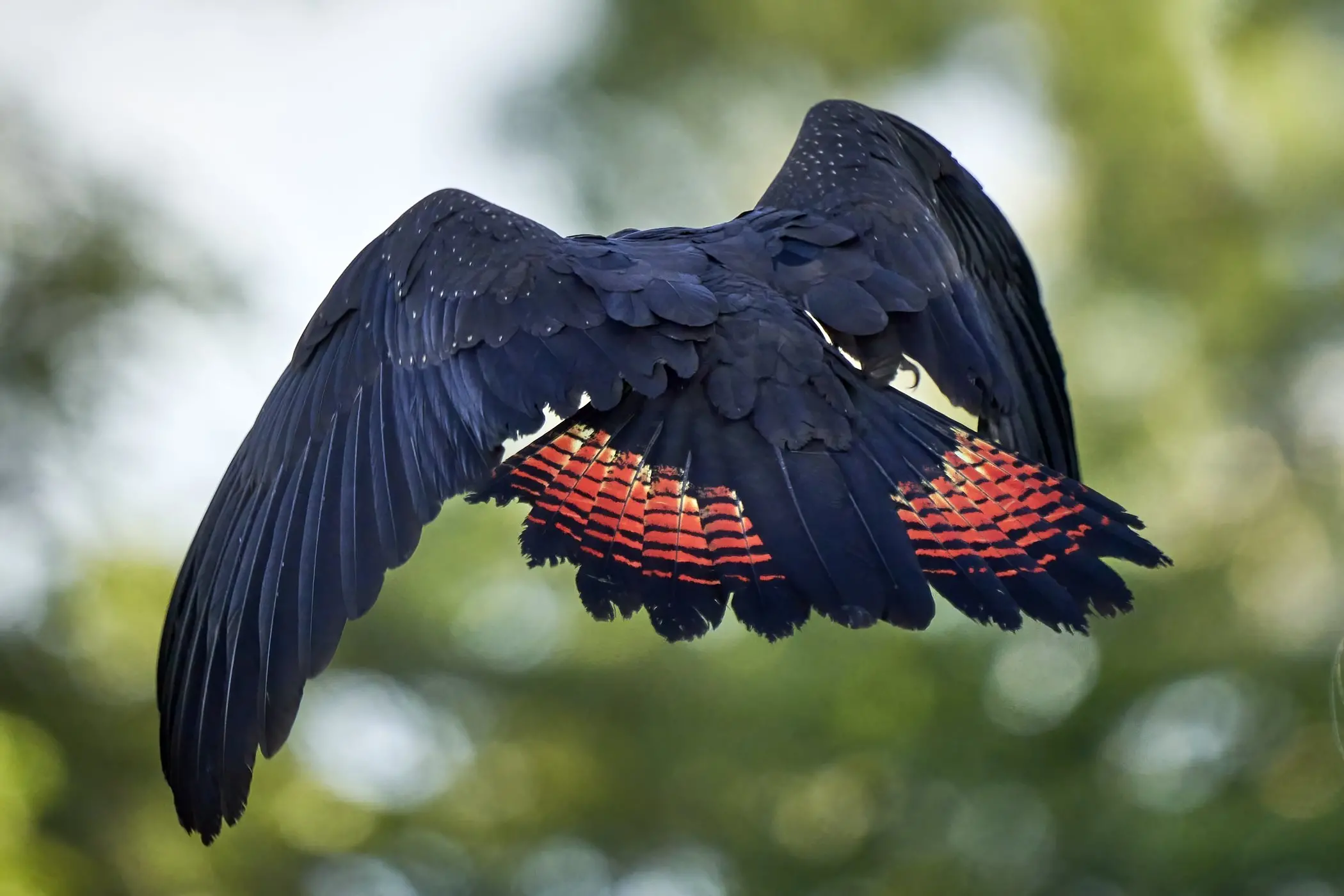
Flock Structure
- Social Structure: Red-tailed Black Cockatoos are inherently social creatures, often flying in flocks with varying sizes. Typically, smaller groups are observed, but larger gatherings can occur when food resources are abundant. These large groups may consist of up to several hundred individuals during feeding times.
- Daily Routines: In the early morning, the flock tends to leave their communal roosting spots and disperse to local water sources before continuing to feeding grounds. This predictable routine underlines the importance of social cohesion and communication among individuals.
- Communication: Vocalizations play a critical role in flock dynamics. Red-tailed Black Cockatoos use a mix of loud, sharp calls during flight to maintain group cohesion, while softer calls facilitate communication when foraging. This layered approach to vocalization helps to manage both social interactions and predator awareness.
- Hierarchical Structures: While detailed information about the hierarchy within flocks remains scarce, it can be inferred that certain behavioral displays reflect dominance and subordinate behavior, particularly during mating seasons.
- Integration Patterns: Behavioral studies indicate that newly introduced members or those rehabilitated back into the wild can integrate successfully into existing flocks, typically within a month. This adaptability brings valuable insights into their social intelligence.
Through an understanding of their social behavior and flock structure, it becomes clear that Red-tailed Black Cockatoos rely heavily on cooperation and communication to navigate their environments, highlighting the intricate dynamics that influence their survival.
Communication and Vocalizations
The communication patterns of Red-tailed Black Cockatoos are remarkably diverse and critical for linking social interactions and maintaining the structure of their flocks. Their vocalizations and interactions provide insights into their behavioral ecology.
- Vocal Repertoire: Red-tailed Black Cockatoos produce a wide array of vocalizations, ranging from loud screeches that can be heard over long distances to softer calls used during feeding or social activities. This variety allows them to maintain flock cohesion despite potential obstacles in their habitat.
- Contact Calls: One of the primary vocalizations utilized by these birds is the contact call an urgent, piercing screech necessary for keeping in touch with fellow flock members. This call is especially crucial in dense habitats where visibility may be limited.
- Territorial Displays: During territorial disputes, males emit aggressive calls to assert dominance, while deep, resonant calls known as “booms” are part of mating displays, serving both territorial claims and potential mate attraction.
- Family Dynamics: Within family units, young birds and their parents utilize softer interactions, reinforcing the bonds that exist during feeding periods and early social learning important for navigation and safety during formative stages.
- Mimicking Abilities: While not natural mimics like some other parrot species, Red-tailed Black Cockatoos are capable of imitating various environmental sounds, providing layers to their communication repertoire.
This intricate communication highlights the social complexities and structures that characterize Red-tailed Black Cockatoos, underscoring their need for strong social ties and interactions essential for survival in dynamic environments.
Social Interactions
Within the social structure of Red-tailed Black Cockatoos, interactions play a key role in establishing relationships and fostering cooperation among flock members. Here are specific aspects of their social behaviors:
- Flock Dynamics: Red-tailed Black Cockatoos exhibit cooperative behaviors during social interactions, especially during feeding. The presence of multiple birds enhances vigilance against potential threats, ensuring their safety.
- Courtship Displays: Males participate in elaborate courtship displays, which include unique vocalizations and physical movements such as wings spreading or head bobbing. These interactions not only attract females but also reinforce social bonds among flock members.
- Alarming Signals: Alarm calls are crucial for alerting fellow flock members of potential dangers, triggering coordinated fugue responses to predators.
- Nesting Interactions: During the breeding season, interactions between parents and young birds are characterized by soft vocal exchanges, helping to foster a protective environment for fledglings. Parents will engage closely with their young, ensuring healthy development through both feeding and social learning.
These social interactions provide a detailed look into the life of Red-tailed Black Cockatoos, revealing how integral their social structures are to their overall survival.
Breeding and Reproduction
Breeding and reproduction are vital stages in the life cycle of the Red-tailed Black Cockatoo, characterized by specific periods of activity and care surrounding their young. The intricacies of their breeding patterns are essential to understanding their ecological role.
Breeding Season
Typically, Red-tailed Black Cockatoos breed from May to September within their range. However, southeastern subspecies timing can vary, with breeding occurring during the warmer months of December to February. The timing connects directly to food availability and environmental conditions, influencing their reproductive success.
Nesting Habits
Red-tailed Black Cockatoos are cavity-nesting birds, favoring hollows in mature eucalyptus trees. These nesting sites are typically located at least 15 meters off the ground, providing safety from grounded predators and environmental exposure.
They utilize existing hollows, frequently lined with decayed wood, to create a comfortable nesting environment. It’s common for females to lay 1 to 2 eggs, although usually only one chick reaches maturity due to the intensive resource allocation by both parents.
Incubation and Chick Development
The incubation period lasts approximately 28 to 30 days, during which the female is primarily responsible for guarding the eggs. The male provides food and sustenance, ensuring the female remains nourished throughout the incubation process so she can fulfill her duties effectively.
Once the eggs hatch, the chicks are born helpless and utterly reliant on their parents for sustenance. They depend on both the mother and father for food, gradually learning to forage as they mature. The young typically fledge around 100 days of age but remain dependent on their parents for several more months after leaving the nest.
Reaching sexual maturity takes about four years, highlighting the critical aspect of parental care and resource allocation required to ensure successful development.
Together, these reproductive behaviors reflect the reliance of the Red-tailed Black Cockatoo on their environment for nesting and survival, emphasizing the importance of suitable habitats in providing the necessary resources for successful breeding.
Conservation Status
The conservation status of the Red-tailed Black Cockatoo varies across its geographic range, but it is generally categorized as “Least Concern” according to the International Union for Conservation of Nature (IUCN). Despite its extensive range, certain subspecies demonstrate declining populations due to habitat pressures.
The southeastern subspecies, for instance, is classified as endangered, with estimates putting their numbers at around 1,400 individuals. Habitat degradation, including urban development and agricultural practices, has led to significant threats against these localized populations. Particularly, this subspecies faces the loss of vital foraging and nesting grounds.
Notably, the Forest Red-tailed Black Cockatoo is another subspecies at risk, estimated to number 10,000 to 12,000 individuals. Vulnerability arises from their infrequent breeding habits, occurring only every two to three years, which exacerbates struggles against habitat loss.
Population Trends
While the general conservation status of the Red-tailed Black Cockatoo appears stable at a national scale, specific subspecies are facing challenges. Conservation initiatives must emphasize habitat protection, restoration, and awareness in the context of ongoing changes to their environments.
| Subspecies | Status | Estimate Population | Notes on Threats |
|---|---|---|---|
| Southeastern Red-tailed Black | Endangered | ~1,400 Individuals | Habitat loss and fragmentation |
| Forest Red-tailed Black | Vulnerable | 10,000 to 12,000 | Infrequent breeding habits |
Threats to Survival
The overarching threats to the Red-tailed Black Cockatoo include habitat destruction, competition for food, and predation. The ongoing challenge of balancing urban development with conservation efforts has become paramount in preserving existing populations.
Additionally, invasive species, such as European honeybees and sugar gliders, create additional competition for nesting sites and food resources. As specialists in their ecological niche, sustaining a population of Red-tailed Black Cockatoos requires active intervention and targeted management strategies.
The cultural importance of these cockatoos for Indigenous Australians further elevates the motivation for conservation efforts, as their survival directly ties into the preservation of cultural heritage and ecological integrity.
Cultural Significance
The Red-tailed Black Cockatoo holds substantial cultural significance across Indigenous Australian societies. Revered for its unique beauty and associated with strong cultural narratives and spiritual beliefs, the cockatoo’s presence echoes throughout storytelling, art, and daily life.
Importance in Indigenous Culture
The importance of the Red-tailed Black Cockatoo within Indigenous cultures is profound. Many Aboriginal communities recognize this bird as an emblem of strength and resilience. Its prominent red tail feathers are often used in traditional ceremonies, signifying respect for their natural surroundings. The stories that surround the Red-tailed Black Cockatoo encompass themes of connection to Country, cultural heritage, and environmental stewardship, highlighting the bond between Indigenous peoples and their land.
Many stories depict the red-tailed black cockatoo as a harbinger of change, with its appearance indicating shifts in weather patterns. Such beliefs engage community members in acknowledging the natural world and acting as custodians of their environment.
Representation in Art and Literature
In artistic expressions, the Red-tailed Black Cockatoo is a subject of choice among Indigenous artists. Various paintings and artworks emphasize its stunning colors and iconic traits, often intertwining traditional stories and knowledge with visual representations. Artists use the cockatoo as a symbol to narrate their experiences and cultural significance in relation to the landscape.
The works of contemporary Aboriginal artists further reflect these themes, with the red-tailed cockatoo appearing in various mediums, from watercolor to printmaking. This artwork serves not only as personal expression but as educational pieces that maintain and celebrate Indigenous narratives and heritage.
In literature, the Red-tailed Black Cockatoo appears prominently in Indigenous storytelling, where it may symbolize particular cultural teachings, moral lessons, or connection to the environment.
Through these means, the Red-tailed Black Cockatoo serves as a reminder of the intricate relationship between nature and cultural identity, underscoring the urgency for conservation efforts that safeguard both the species and the heritage they represent.
Fun Facts
The Red-tailed Black Cockatoo is rich in unique behaviors and adaptations that make it a captivating species. Here are some fun facts that showcase their distinct identity within the avian world:
- Distinctive Appearance: The vibrant contrast between male and female plumage makes this species easy to identify. Males display glossy black feathers accentuated by striking red panels, while females feature muted black with splashes of yellow.
- Vocalization: These birds are known for their loud calls, which echo through their habitats. Their piercing screeches can be heard from great distances, often serving as alarms or communication mechanisms among flocks.
- Monogamous Relationships: Red-tailed Black Cockatoos typically form lifelong partnerships, with strong bonds developed between mates. If one partner is lost, surviving members may remain solitary, displaying their loyalty to one another.
- Dietary Habits: Their diet indicates their role as seed dispersers within their ecosystems. Their strong beaks and feeding habits allow them to access seeds from tough pods, promoting vegetation regrowth.
- Nesting Behavior: Nesting high within eucalyptus trees is a strategic means of protecting offspring, as these elevated hollows provide safety from ground predators.
- Lifespan: In the wild, these cockatoos can live around 20 years, but with proper care in captivity, they can survive for up to 50 years.
- Cultural Symbolism: Indigenous Australians often consider the arrival of the Red-tailed Black Cockatoo as a portent of rain, illustrating the bird’s deep connection to the land and weather patterns.
- Migration and Seasonal Behavior: While not fully migratory, Red-tailed Black Cockatoos exhibit regular seasonal movements influenced by food availability, often seen flying in small flocks for safety.
These unique characteristics contribute to the allure of Red-tailed Black Cockatoos, emphasizing their ecological importance and cultural resonance within Australian heritage.
Unique Behaviors
Red-tailed Black Cockatoos also display a range of unique behaviors that highlight their adaptation to their environments:
- Social Foraging: They typically forage in flocks, utilizing group dynamics to locate food efficiently while acting as a collective safety measure against potential threats.
- Courtship Displays: Males engage in elaborate aerial displays, showcasing their feathers and performs vocalizations to attract mates during the breeding season.
- Nesting Instincts: Strong parental bonds lead to cooperative nesting habits, where both parents contribute to feeding and caring for the chicks until they are independent.
- Environmental Awareness: Their vocalizations indicate heightened levels of awareness regarding environmental changes, signaling each other of threats and resource availability.
These unique behaviors accentuate the intricate social lives of Red-tailed Black Cockatoos while reinforcing the importance of their habitats.
Interesting Adaptations
The adaptability of Red-tailed Black Cockatoos to their environment is remarkable. Some notable adaptations include:
- Zygodactyl Feet: Their specialized foot structure allows them to grip and manipulate food sources effectively, utilizing both feet for balance.
- Dietary Specialization: Their feeding habits have evolved to exploit specific seeds that promote the regeneration of local vegetation, cementing their role in ecosystem health.
- Long Lifespan: Their longevity contributes to stable social structures, enabling them to develop complex social interactions within flocks.
These adaptations foster both individual and species survival, highlighting their ecological roles within the diverse Australian landscape.
In conclusion, the Red-tailed Black Cockatoo is an avian marvel with distinct features, rich cultural ties, and complex social behaviors that deserve recognition and conservation. Protecting their habitats and fostering greater understanding of these birds will not only ensure their survival but also enrich the cultural tapestry of the regions they inhabit. The intersection of their life cycles, ecological significance, and cultural heritage renders them a potent symbol of nature’s intricacies.





